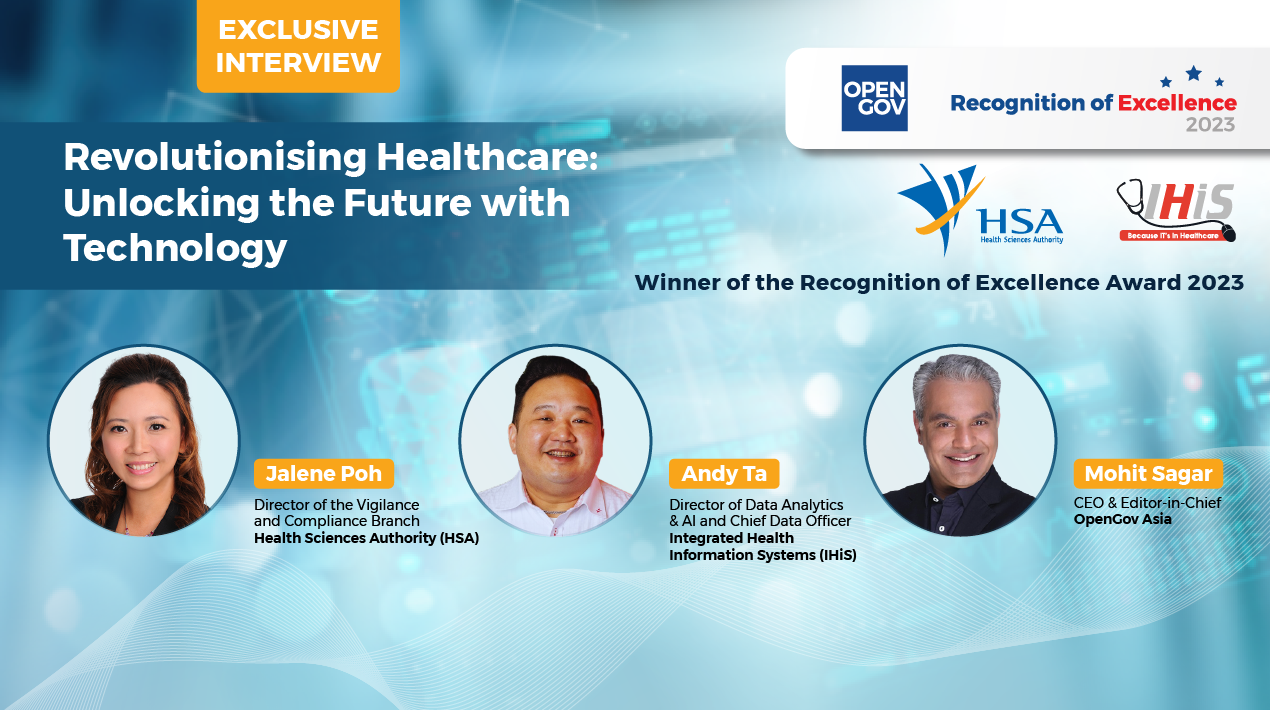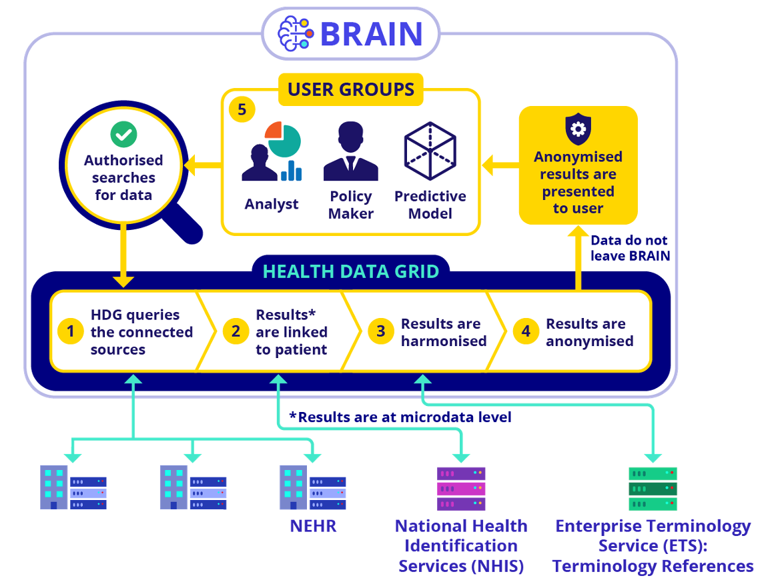
OpenGov Asia acknowledges the advancements made by Singapore’s Integrated Health Information Systems (IHiS) and the Health Sciences Authority (HSA) in their utilisation of technology within the public sector.
The agencies have streamlined government processes and are pushing new boundaries with the Active Surveillance System for Adverse Reactions to Medicines and Vaccines (ASAR) Project. The initiative is an extension of IHiS and HSA’s ongoing efforts to actively monitor the safety of COVID-19 vaccines approved in Singapore.
The ASAR project empowers HSA to proactively monitor the safety of COVID-19 vaccines that have been approved in Singapore, ensuring that the benefits outweigh possible risks and that the vaccinations remain safe and efficacious.
To achieve this, ASAR complements the conventional approach of spontaneous adverse event (AE) reporting with active surveillance, using de-identified electronic health records to detect and validate potential safety signals.
By leveraging ASAR-based investigations and findings, HSA was able to detect early safety signals and implement timely risk mitigation measures to safeguard public health. This approach has also assisted in informing vaccination policies by the Ministry of Health (MOH) and the Expert Committee on COVID-19 Vaccination (EC19V).
These efforts have resulted in IHiS and HSA receiving the prestigious OpenGov Asia Recognition of Excellence Award, which will be presented at the 8th Annual Singapore OpenGov Leadership Forum 2023.
ASAR Impact on Surveillance Health in Singapore
 Jalene Poh, the Director of the Vigilance and Compliance Branch at HSA, acknowledges that achieving population-wide immunity has been crucial to Singapore’s strategy for exiting the COVID-19 pandemic. To this end, COVID-19 vaccines have been rolled out to almost the entire population of Singapore.
Jalene Poh, the Director of the Vigilance and Compliance Branch at HSA, acknowledges that achieving population-wide immunity has been crucial to Singapore’s strategy for exiting the COVID-19 pandemic. To this end, COVID-19 vaccines have been rolled out to almost the entire population of Singapore.
“With such a nationwide deployment, there was a need to establish an active safety surveillance system for early detection of emerging safety signals and more comprehensive safety monitoring, instead of relying mainly on spontaneous reporting of adverse events by healthcare professionals and companies,” Jalene explains.
The establishment of this system within a short timeframe was the result of collaboration across the entire government, which began well before the first COVID-19 vaccine was approved in Singapore. As a result, the interoperability and accessibility of databases played a critical role in the successful implementation of ASAR.
Leveraging access to extensive datasets, HSA, IHiS, MOH and the Health Promotion Board (HPB) worked expeditiously to set up the necessary IT systems and processes for recording all COVID-19 vaccinations.
In addition, they ensured that the requisite datasets were incorporated into the Business Research Analytics Insights Network (BRAIN) and updated daily. This enabled HSA and IHiS to develop ASAR’s analytical tools.
Andy Ta, the Director of Data Analytics & AI and Chief Data Officer at IHiS, emphasises that ASAR is an active surveillance programme established to facilitate the safety monitoring of the National COVID-19 Vaccination Programme, by harnessing electronic medical records on a national level.
To detect and analyse pharmaceutical safety signals, ASAR employs AI to centrally aggregate over 2 million de-identified structured and unstructured records from various sources every day.
An AI-powered deep-learning algorithm for detecting adverse events related to medicines has been implemented and is layered on top of the records. This algorithm allows HSA officers to identify possible links between reported symptoms and the medicines or vaccines administered.
The implementation of this system has made it easier for HSA to conduct further research, which could lead to better safety measures to safeguard public health.
According to Jalene, ASAR has enabled HSA to identify and analyse possible safety signals, such as the incidence of adverse events in the vaccinated population and associated risk factors. This facilitates prompt action to mitigate safety risks.
For example, ASAR helped HSA analyse the adverse events of anaphylaxis, which is a rare and potentially life-threatening allergic reaction and myocarditis, which is inflammation of the heart, associated with the COVID-19 vaccines.
As a result, risk mitigation strategies were introduced, including a 30-minute observation period after COVID-19 vaccination to monitor for anaphylaxis and advising individuals to refrain from engaging in strenuous physical activity for two weeks following vaccination to prevent myocarditis.
ASAR was also used by HSA to examine the frequency of serious events, such as myocardial infarction (heart attack), occurring after COVID-19 vaccination. Their findings showed no increase in the occurrence of these events post-vaccination compared to before vaccination.
HSA publishes its safety findings to keep the public and healthcare professionals up to date on the current safety profile of the COVID-19 vaccines. As of February 2023, a total of 14 safety reports have been published, which helped instil public confidence in the vaccines used in the national vaccination campaign.
Jalene suggests that while doctors and drug companies are typically responsible for reporting adverse events in traditional adverse event monitoring systems, there may be a significant amount of underreporting and delays in reporting.
“The use of electronic health records for safety surveillance offers significant opportunities to tap real-world data to detect and quantify the risk of adverse events in near real-time,” she is convinced.
ASAR is the first nationwide system that utilises both structured and unstructured medical records taken from public acute hospitals and national databases to conduct active safety surveillance on a secure platform called BRAIN.
The successful implementation of ASAR paves the way for active safety surveillance to be used on all locally supplied medicines and vaccines to identify and validate potential safety signals.
According to Andy, HSA and IHiS collaborated to develop tools that leverage the nature of their existing Electronic Medical Record (EMR) data to detect, analyse, and confirm potential safety signals. ASAR was developed quickly using an iterative and agile approach, with new features added every 8 to 10 weeks to enhance its functionality.
ASAR has 5 key elements that include built-in analytics and AI. These features let users form a cohort based on pre-set parameters and explore different data domains to look for possible safety signals associated with medicines or vaccines.
The “Smart to Search” option facilitates the quick and easy identification of the desired cohort. Its ability to aggregate information from diverse clusters and over time into a unified, patient-centred view is also extremely valuable.
The system utilises AI to generate visualisations and provide contextual insights, enabling users to quickly make informed decisions. The annotation functions simplify collaboration between pharmacists and analysts and provide the AI model with human input, allowing for continuous improvement.
All of these enable HSA analysts to quickly identify groups of interest, such as patients who experienced adverse events after receiving vaccinations.
The patient-level clinical review tool provides pharmacovigilance officers with a user-friendly means of examining the medical records of such patient groups and deriving insights from them, Jalene believes. It makes it easier to conduct well-controlled pharmacoepidemiological analyses and quantify the link between vaccine exposure and potential adverse event outcomes of interest.
The enhanced safety monitoring enabled by ASAR and the patient-level clinical review tool results in more comprehensive surveillance and timely interventions, ultimately enhancing the safety of vaccines and medicines for Singapore.
Andy explained that they adopted a multi-pronged approach to managing their data, incorporating industry best practices to ensure compliance with regulations, safeguard privacy, and maintain the integrity of the data processed by their systems.
This strategy helps make sure that business decisions are based on data that can be trusted and is correct and includes:
- A governance structure where owners and stakeholders are identified early on
- Creating strong data processes in place for collection, anonymisation, storing, processing and analysing
- Adopting the right tools, platform and technology to establish a secure data infrastructure to manage the data with the analytics environment
BRAIN-Powered: ASAR’s Core for Modern Analytics
The core of ASAR is BRAIN, which boasts a robust, modern analytics architecture that enables the addition of new features and use cases to address evolving needs, Andy reveals.
 BRAIN runs “on top” of hospitals’ existing data warehouse infrastructure and retrieves the most up-to-date data from source systems as soon as it becomes available.
BRAIN runs “on top” of hospitals’ existing data warehouse infrastructure and retrieves the most up-to-date data from source systems as soon as it becomes available.
BRAIN is separated into development and implementation environments with similar system configurations. This greatly reduces the time and effort needed to put the different modules for predictive analytics, data analysis, signal detection, signal validation, and benefit-risk assessment of medicines and vaccines into production.
“To manage the vast and high-velocity data required for the ASAR, we utilise existing data pipelines and perform real-time pipeline processing. Different techniques such as batch, real-time or a combination of the two are used to ensure smooth performance of the analytics,” Andy elaborates.
Technology and data analytics will be the key to changing the healthcare system as Singapore moves to a “Healthier SG” to help Singaporeans take charge of their health.
ASAR can efficiently and accurately look at large amounts of data to learn important things about the safety and effectiveness of medicines and vaccines. Machine learning algorithms can assist analysts in quickly identifying cohorts of interest by investigating both structured records and unstructured notes at the patient and cohort level, enabling valuable insights for medicine safety surveillance.
There is a chance that ASAR could be broken up into different parts, such as modules that do strategic segmentation and analysis of textual information and could be used by other healthcare institutions to analyse patients.
Moreover, a feedback loop can be set up with ASAR so that healthcare institutions can share information about the safety of medicines to help with clinical care.
“ASAR has enabled HSA to detect, analyse and validate potential safety signals associated with COVID-19 vaccines, and has laid a strong foundation to scale up our capabilities,” says Jalene.
There are approximately 5,500 medicines and vaccines registered in Singapore, and numerous novel medicines and vaccines are expected to be introduced in the future due to paradigm shifts in medicine development.
This will necessitate the implementation of rigorous safety monitoring and HSA and IHiS are actively working towards the refinement of ASAR to meet this need.
“Our primary objective is to prioritise the continuous improvement of ASAR’s infrastructure, technology, and operations to access real-world data for the detection and quantification of the risk of adverse events,” confirms Jalene, “Ultimately we want to ensure that the benefit-risk ratio of medicines and vaccines administered in Singapore remains positive for public safety.”
ASAR modules may be included in any other analytical platform including electronic health records, such as the newly created MOH Consolidated Data Repository. This will enable the adaptability and evolution of diverse data sources and data systems, as well as the interoperability of systems.
“We will continue to future-proof our technologies so that if we are faced with another pandemic or other similar events in the future, we will be undaunted,” she reiterates.
Agile Mindset: Team Adoption for Evolving Product
 Andy says that their team is constantly exploring state-of-the-art tools and algorithms to enhance the capabilities of ASAR. “For instance, we are looking at graph analytics and algorithms to better understand how patients interact with the different touchpoints within the health system through their care journey resulting from a health event of interest, such as an adverse event.”
Andy says that their team is constantly exploring state-of-the-art tools and algorithms to enhance the capabilities of ASAR. “For instance, we are looking at graph analytics and algorithms to better understand how patients interact with the different touchpoints within the health system through their care journey resulting from a health event of interest, such as an adverse event.”
By mapping the patient healthcare journey more holistically, they hope to better uncover early safety signals and valuable insights quickly and more accurately.
The team is currently investigating the possibility of incorporating embedding and tokenisation layers from state-of-the-art Large Language Models (LLMs) such as GPT (Generative Pre-trained Transformer) and T5 (Text-To-Text Transfer Transformer), to further improve the performance of their AI model, adds Jalene.
The development of this project was accelerated by leveraging two key methodologies: Agile and Design Thinking.
As per Andy, the development team embraces an agile management style that emphasises adaptability, cooperation and continuous improvement. Rather than adhering rigidly to a pre-established strategy, the agile model involves creating an outline, delivering something in a short timeframe and making adjustments based on the evolving project requirements.
To build a flexible application, they employ web frameworks such as SpringBoot and Angular that allow modularisation and experimentation. They regularly organise user meetings to involve HSA users from the outset, starting from wireframe creation through to feedback collection before final production. The goal is to prioritise and establish defined, agreed-upon deliverables for each iterative release.
They have design thinking and user interaction sessions to identify other possibilities where analytics and AI could play an active role. Post-It notes and charts are used to map out the user experience and identify potential opportunities and gaps.
Knowing the consumers’ end goal makes it easier for the team to transform that aim into well-defined project requirements and objectives.
The key, according to Jalene, is to have a shared vision and objective, which is to transition from passive to active medicine safety surveillance utilising electronic health records and analytics. “Once the various members comprehend the significance of their task, they see themselves as indispensable members of a team collaborating to accomplish something significant.”
Everyone is encouraged to share their ideas and challenge the status quo. In case of any problems or disagreements, they meet and openly discuss the issues, identify limitations, and arrive at a resolution before moving forward.
The team members are expected to adopt an agile mindset, where they view the application as an evolving product, work in sprints, prioritise specific enhancements and gradually release new versions with each iteration.
Andy explains that in the daily checkpoint meetings, the team’s progress will be monitored, and members will be requested to report any issues or concerns. Because of their great team dynamic, members step up to offer advice on other members’ queries, even if they are not directly involved.
If any impediments are detected during these daily check-ins, assignments can be swiftly recalibrated to meet the deadline once a clear timeframe has been established. These strategies allowed the team to swiftly develop ASAR, with updates being provided every 8 to 10 weeks to broaden its functionality.
IHiS and HSA are dedicated to advancing public service through the collective efforts of all team members and their endeavours to broaden technological applications in the public sector.
The team is confident that they can continue to serve the country by combining IHiS’s objective to digitise, connect, and analyze Singapore’s health ecosystem with HSA’s purpose to wisely regulate health products and protect public health.
















